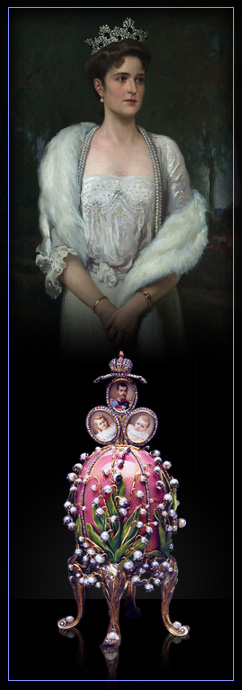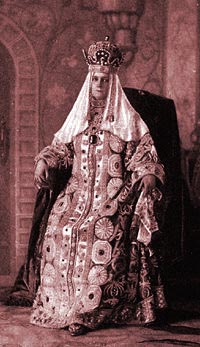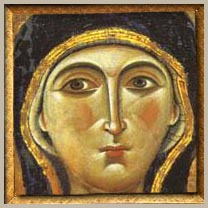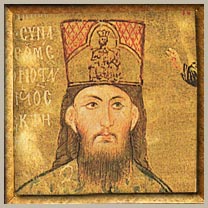This icon was the Imperial standard of Constantinople and was paraded along the walls and carried into battle by emperors. Crusader loot - it's now in Venice


 Chapter XIForiegn Trips, and Life from 1901-1904In the friendship of the Grand Duchesses Militza and Stana (Anastasia Nicholaevna), the Empress found the one thing that had been missing in her life since her friend Princess Bariatinsky had left for Rome - congenial society in the hours when the Emperor was busy. The Grand Duchesses did not help the Empress to enlarge her circle. They were not fond of society and their meetings were always enfamille. The abstract interests into which they initiated her did not change her mode of life, nor did they appear to influence her outwardly. She was always cheerful at home, and full of interest in her family. She was now beginning to think of her children's education, giving her eldest daughter her early lessons herself, and her interest in charities increased. During the years 1897-1905 the Emperor and Empress went abroad nearly every second year or received State visits in Russia. The King of Italy came to Peterhof in 1901; the visit was returned in 1911. President Loubet also came to Russia in 1901, the Russian Sovereigns returning the visit in the autumn of the same year. On their way to France, they stayed again with old King Christian at Copenhagen. On this occasion, too, the Emperor met the German Emperor at Danzig, and the Empress paid a flying visit to Princess Henry of Prussia at Kiel, where she left her three small daughters during the State visit to France. This French trip began most inauspiciously. The Standart, though she was wonderfully steady, had never met such a storm as that encountered between Germany and the French coast. The Emperor, who was an excellent sailor, saw his suite disappear, one by one, on different pretexts. The Empress was invisible, and soon the groans of the ladies and their maids began to resound through the ship. Loud supplications were heard that the ship should stop. They could not realise that they were on the high seas, and that there was no land in sight! Dunkirk, when it was at last reached, was no haven of rest to the Empress, for she had to appear on deck to meet the French President, her ladies crawling up behind her like flies in autumn. It was some slight consolation to Her Majesty to discover that the French President also had no sea-legs, and had to stay on board the Standart during the naval review, the weather being too bad for him to reach a French man-of-war. An amusing picture in an illustration of the time shows the French deputies, who had come to see the review, all huddled together on deck, and presenting the picture of abject misery often seen in a Channel crossing. This picture was accompanied by an extract from the telegram from the President of the Chamber to the Minister of Marine saying-was it with sarcasm ? - C'était un spectacle reconfortant de voir, etc. . . . The unfriendly reception of the elements was forgotten at Compiègne, where the Imperial couple spent a day as guests of the French President. Paris was not visited by them this time, to the great disappointment of the public, but the Emperor had come, chiefly, to be present at the great French manoeuvres, where he went with President Loubet from Compiègne, the Empress accompanying him. At Compiègne (September 28th) the visit was planned on much the same lines as had been the memorable day at Versailles in 1896, but here was the Napoleonic setting. The Empress enjoyed her day, when she could roam about the park and visit it all. In the evening there were also theatricals following upon the State banquet, but the programme was naturally less full than it had been at Versailles. The Empress was pleased to meet some people and friends she knew, among them the Marquis and Marquise de Montebello, the French Ambassador in Russia at the time of their Coronation. The Emperor stood sponsor on that occasion to the first grandson of the Marquis and Marquise, the late Nicholas de Montebello. In the course of the subsequent manoeuvres, during which the great review of the French army at Béthény was held, the Imperial couple visited Rheims. For the first time since the fall of the Second Empire, the choir of the cathedral intoned Domine salvum fac imperatorem. The Empress said later to me that this was a great reminder of the instability of all earthly power to her ; the scene was beautiful, and she was sorry not to be able to linger and visit it properly, but the official programme had to be fulfilled. Up to 1905 the Emperor and Empress went every year to St. Petersburg for the winter season. In 1901/2 and 1902/3 a Grand Ball, two or three concert balls, and several balls at the Hermitage Palace were given, followed by the Folle Journée before Lent. The Diplomatic Corps were received on New Year's Day, and were entertained to luncheon after the ceremony of blessing the waters, which took place on the ice of the Neva at Epiphany. The Empress was at this time in the full height of her beauty. The Emperor's favourite picture of her, the portrait by Kaulbach, was painted in 1903, and is an excellent likeness. Her well-cut features, upright figure, wonderful eyes, and golden hair made her the embodiment of what an Empress should be. Children and peasants did not need to see crown or mantle to know she was the "Tsaritsa." Her face was generally sad it was her official expression, the photographic face of her youth. It seldom lighted up in public with the particularly charming smile that those knew so well who saw her in private life. Men and women of society vied with one another at this ball. The most gorgeous stuffs, jewels and furs were produced from private collections. Officers wore the uniforms of the time, Court people the dress of Tsar Alexei's court. The Grand Duchesses wore dresses of the style of their ancestors, designed by the greatest modern artists, the Grand Duchess Serge looking best of all. The Empress and her three sisters, 1903. Old Russian dances, carefully rehearsed, were danced, and the whole effect was marvellous. This was the last great festivity of the Russian Court. The season of 1903 /4 was cut short by the outbreak of the Japanese War, and no balls were ever given again. The autumn of 1903 saw the Imperial couple and their children at Darmstadt. Half the royalties of Europe were collected there for the wedding of the Empress's niece, Princess Alice of Battenberg, to the King of Greece's son, Prince Andrew. This like all family events, was a matter of great interest to the Empress. She wrote of this engagement to her sister, Princess Louis: "May she be as happy as we are [the Emperor and herself], more one cannot wish " (August 16th, 1902). The young couple were securely married in the Orthodox church, the Protestant church, and at a civil wedding. In the middle of the wedding festivities, the Empress's young lady-in-waiting, Princess Sonia Orbeliani, fell desperately ill. She was an orphan, and the Empress, notwithstanding all the ceremonies at which she had to appear and the claims of her family, nursed her like one of her own children. Every free hour she spent with the half-conscious invalid, and when the whole wedding patty moved to Schloss Wolfsgarten, the Empress motored up to Darmstadt sometimes thrice a day to see Sonia, which seemed almost a breach of etiquette to the stricter Court people. After the wedding the Grand Duke of Hesse and his little daughter Elizabeth went with the Imperial Family to their shooting box at Skietniewice in Poland. This stay was planned principally to give the Grand Duke a change. He led a solitary life at Darmstadt, having just been separated from his first wife. Little Princess Elizabeth was a singularly captivating and beautiful child, adored by both her parents. She sickened soon after arriving at Skierniewice, having probably come to Poland with the bacillus of typhoid in her, and she died in a few days from a virulent form of ambulatory typhoid. Wild stories were current at the time, but the post-mortem and the testimony of all the doctors leave no doubt as to the cause of her death. It was a terrible blow to the Grand Duke and to the Empress, whose grief was increased by the fact that the tragedy should have happened in her house. It was only thanks to her moral support she never left him-that her brother got through that dreadful time. After the Grand Duke had gone to his child's funeral at Darmstadt, the Empress fell ill, and had to be in bed for some time. She was completely worn out, for she always felt the sorrows of those dear to her even more acutely than her own.
|
|
Alexandra Feodorovna was the last Romanov Empress of Imperial Russia. This online book - The Life and Tragedy of Alexandra Feororvna was written by Countess Sophie Buxhoeveden, Lady-in-Waiting to the Empress, who served the Empress for many years and followed the Imperial family into exile. |

- Early Surroundings
- Childhood
- A Young Princess
- Engagement
- Marriage
- Her New Home
- Coronation
- Journeys
- Charities and Life
- Queen Victoria
- Foreign Trips
- Birth of Alexis
- Gathering Clouds
- On the Standart
- Rasputin
- Her Family
- Empress at Home
- Last Years of Peace
- Wartime 1914
- War Work
- Without the Emperor
- Visits to Headquarters
- Before the Storm
- Warning Voices
- Rasputin's Murder
- Revolution 1917
- Abdication of the Emperor
- Prisoners
- Five Weary Months
- Tobolsk
- Ekaterinburg 1918


 Left: The Empress in her costume for the 1903 Ball at the Hermitage.
Left: The Empress in her costume for the 1903 Ball at the Hermitage.


